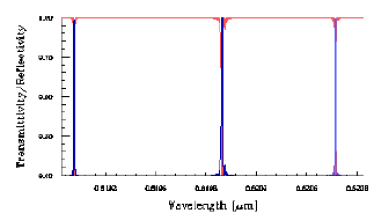Reference
C.-X. Shi and T. Okoshi, ‘Mode conversion based on the periodic coupling by a
reflective fiber grating,’ Opt. Lett., vol.17, No.23, pp.1655-1657, (1992).
Description
The example demonstrates the mode conversion between the LP01 and LP02 mode
in a fiber with Bragg grating. The fiber has four LP core modes. In the example, only
three core modes, LP01, LP02, and LP11, are selected for calculations. The grating
period, 0.21436546 microns, allows the coupling between the forward propagating
LP01 mode and the backward propagating LP02 mode.
The main results are the narrow reflection and transmission spectra showing the
conversion of selected modes.
Note: For this example, the file includes all the design data and the calculation
results.
Spectrum
The left-hand side peak is the mode conversion form LP01 mode to backward LP02. The right hand side peak is the coupling between LP01 mode to its backward mode.
Set the grating tilted angle to 3.0 degrees and click the Calculation button again.
Spectrum with tilted angle of 3.0°
The peak at the middle is the mode conversion from the LP01 mode to the backward
LP11 mode.



